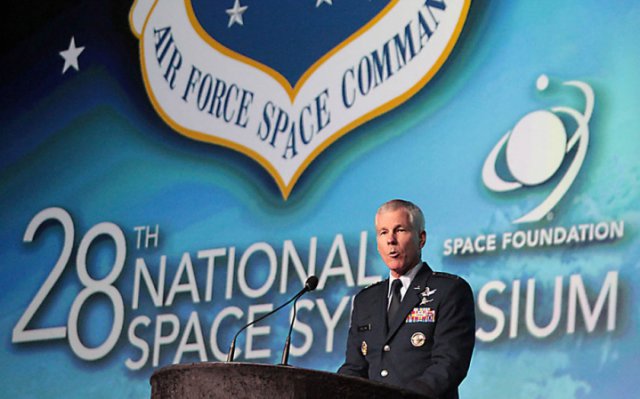 In the recent Space Symposium’s opening keynote speech, General William Shelton called for change with statements that the status quo isn’t a reasonable option anymore and that he struggles with “naysayers”.
In the recent Space Symposium’s opening keynote speech, General William Shelton called for change with statements that the status quo isn’t a reasonable option anymore and that he struggles with “naysayers”.
He did not have to say what the nearly 9,000 space community experts at the 29thannual Colorado Springs event already knew quite well – those naysayers have routinely squashed innovation such as Unmanned Aircraft Systems (UAS) designed to deliver satellite-like capabilities.
General Shelton opened by comparing America’s space architecture to the well engineered, very strong but thin rope that connects mountain climbers. They trust that rope with their lives but know that it has no backup. If it breaks, very bad things happen to the people who depend on it. The Air Force Space Command leader made it clear that America’s military is like those climbers, dependent on a thin rope of space-based capabilities.
He went on to define the perfect fiscal storm that limits his choices, exacerbating the thin-architecture threat. Taken together, the lack of backups plus our reliance on space capabilities plus limited resources put America’s military space programme at a serious ‘fork in the road’. One path represents the status quo while the other path represents change.
General Shelton made it clear that change is the only viable choice. Space warriors need systems that find the “sweet spot” of affordability, resiliency and robust capability.
This change from previous space commanders’ defence of the status quo is quite significant. That defence was so strong at one time that Space Command staffs actively countermanded Air Force Chief of Staff orders to develop UAS that would remain above the jet stream for months or years. Such UAS, likely unmanned airships, would deliver satellite-like capabilities at a fraction of satellite costs. They would have been a game-changer with unique communication, counter-IED and ballistic missile defense capabilities. Though also intended to support space services through space situational awareness, communication relays, reconstitution, supplementation, etc., those earlier Space Command staffs saw the superior orders primarily as a threat to their budgets and so killed the initiative when that Chief of Staff retired.
Perhaps General Shelton will return to the UAS work once generically termed “near space” as an affordable means to improve his space architecture, despite the naysayers who apparently remain committed to the status quo?
Photo: General William L. Shelton, USAF, Commander, Air Force Space Command
Source: Market Info Group
